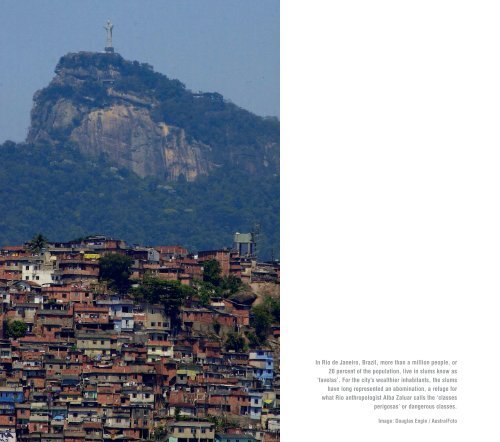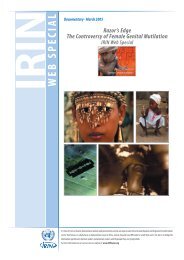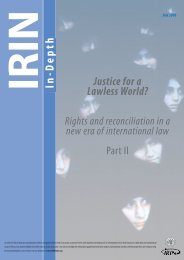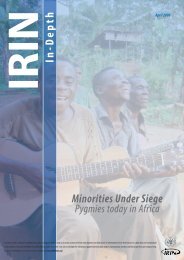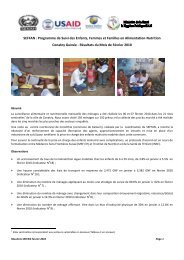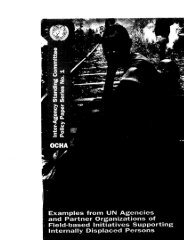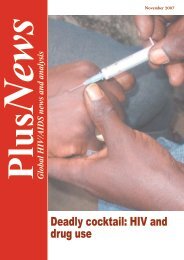You also want an ePaper? Increase the reach of your titles
YUMPU automatically turns print PDFs into web optimized ePapers that Google loves.
In <strong>Rio</strong> de Janeiro, Brazil, more than a million people, or<br />
20 percent of <strong>the</strong> population, live in slums know as<br />
‘<strong>favelas</strong>’. For <strong>the</strong> city’s wealthier inhabitants, <strong>the</strong> slums<br />
have long represented an abomination, a refuge <strong>for</strong><br />
what <strong>Rio</strong> anthropologist Alba Zaluar calls <strong>the</strong> ‘classes<br />
perigosas’ or dangerous classes.<br />
Image: Douglas Engle / AustralFoto
Chapter 6<br />
human insecurity<br />
rio: <strong>fighting</strong> <strong>for</strong> <strong>the</strong> <strong>favelas</strong><br />
“The Brazilian government has made a big ef<strong>for</strong>t to say that <strong>Rio</strong> is a place of beaches,<br />
beautiful bottoms [and] physical beauty… [But] <strong>the</strong>re are areas in <strong>Rio</strong> de Janeiro that are<br />
veritable war zones,” says Andre Dahmer, one of <strong>the</strong> creators of a new website called<br />
<strong>Rio</strong> Body Count.<br />
“I’m really scared of dying but what can I do?” one teenage drug trafficker, and fa<strong>the</strong>r<br />
of one, asked recently during a visit to <strong>the</strong> Fumace favela in Realengo, on <strong>the</strong> western<br />
outskirts of <strong>Rio</strong>. “We’re not here because we like it. We’re here because we have<br />
families… I have a small child and <strong>the</strong>re is no o<strong>the</strong>r work.”<br />
“When I arrived home <strong>the</strong>y told me my wife was in <strong>the</strong> hospital and that<br />
she’d been shot while she sat in our bedroom,” said Ricardo Alexandre<br />
Santino da Silva, a 31-year-old supermarket worker and resident of <strong>the</strong><br />
Chatuba slum in <strong>Rio</strong> de Janeiro.<br />
Like many residents of <strong>the</strong> shantytown, da Silva is an immigrant<br />
from Brazil’s impoverished nor<strong>the</strong>ast who came to <strong>Rio</strong> in search of<br />
work. The huge influx of migrants from o<strong>the</strong>r Brazilian states,<br />
principally since <strong>the</strong> 1950s, has contributed to a massive social and<br />
security crisis.<br />
“I remember <strong>the</strong> first night when we moved here [to <strong>Rio</strong>]. I sat at home<br />
watching <strong>the</strong> tracer bullets flying through <strong>the</strong> sky,” said da Silva, who<br />
was brought up in <strong>the</strong> rural town of Valenca, Pernambuco State. “I said,<br />
‘Look, <strong>the</strong>se bullets must be hitting someone’s house.’ I just never<br />
thought it would be mine.”<br />
The ‘<strong>favelas</strong>’, or shantytowns, of <strong>Rio</strong> de Janeiro began to spring up<br />
towards <strong>the</strong> end of <strong>the</strong> nineteenth century. Following <strong>the</strong> abolition of<br />
slavery in 1888, freed slaves began flocking to Brazil’s <strong>the</strong>n-capital in<br />
search of work. They set up home in poorly constructed slums built on<br />
<strong>the</strong> only land that was available, usually hilltops or swamps on <strong>the</strong><br />
city’s limits.<br />
It was not until <strong>the</strong> mid-1990s that <strong>the</strong> <strong>favelas</strong> were included on city<br />
maps. For <strong>the</strong> city’s wealthier inhabitants, <strong>the</strong> slums have long<br />
represented an abomination, a refuge <strong>for</strong> what <strong>Rio</strong> anthropologist Alba<br />
Zaluar calls <strong>the</strong> ’classes perigosas’ or dangerous classes. 1 Over <strong>the</strong> last<br />
r i o : f i g h t i n g f o r t h e f a v e l a s 57
century, governments have made numerous attempts to eradicate this<br />
“stain” from <strong>Rio</strong>’s landscape, including removal programmes and <strong>the</strong><br />
construction of housing projects on <strong>the</strong> city’s outskirts.<br />
As yet, however, no adequate solution has been found <strong>for</strong> <strong>Rio</strong>’s slum<br />
problem, or indeed that of o<strong>the</strong>r large Brazilian cities such as Sao Paulo,<br />
Belo Horizonte, Recife or Belem. By 2001, according to that year’s<br />
census, more than one million Brazilians were living in <strong>Rio</strong>’s cramped<br />
<strong>favelas</strong> – or about 20 percent of <strong>the</strong> population. 2<br />
‘comunas’ have suffered a similar process to <strong>Rio</strong>’s <strong>favelas</strong>, with <strong>the</strong><br />
problems associated with urbanisation bolstering <strong>the</strong> ranks of <strong>the</strong><br />
‘pandillo’ gangs, made up of disillusioned young men.<br />
In Africa, too, <strong>the</strong> impact of urbanisation on security levels has been<br />
dramatic. A recent police crackdown on gang activity in Nairobi,<br />
Kenya’s Mathare slum, in which at least 30 people were killed,<br />
underlined <strong>the</strong> problems <strong>the</strong> East African city is facing, many of which<br />
directly stem from issues of overcrowding and urbanisation.<br />
Overpopulation, <strong>the</strong> direct result of a 40-year trend of urbanisation and<br />
high birth rates, has caused an unprecedented social crisis affecting<br />
education, public health and public security.<br />
During <strong>the</strong> 1950s Brazil underwent a massive industrialisation drive<br />
under <strong>the</strong>n-president Juscelino Kubitschek. The rate of urbanisation<br />
rocketed, as thousands flocked from rural Brazil into <strong>the</strong> cities.<br />
According to <strong>the</strong> Brazilian Institute of Geography and Statistics (IBGE),<br />
Brazil was still a predominantly rural country until <strong>the</strong> 1960s. Since <strong>the</strong>n <strong>the</strong><br />
rate of urbanisation has climbed from 44.7 percent (1960) to 67.6 percent<br />
(1980). Between 1991 and 1996, more than<br />
12 million Brazilians moved from rural to<br />
urban Brazil. 3 According to <strong>the</strong> IBGE’s<br />
2000 census, over 80 percent of <strong>the</strong><br />
population now live in urban Brazil.<br />
The Brazilian sociologist and <strong>for</strong>mer <strong>Rio</strong><br />
security secretary Luiz Eduardo Soares<br />
traces a clear path between <strong>the</strong> process of urbanisation and <strong>the</strong> explosion<br />
of urban violence in Brazil’s sou<strong>the</strong>rn metropolises. “In less than two<br />
decades [1960-1980] a country that had 70% of its population in rural<br />
areas, transferred itself, en masse, to <strong>the</strong> cities in a chaotic way and in<br />
extreme conditions of deprivation, exploitation and poverty,” he writes. 4<br />
The result, Soares continues, was “social, economic, political and<br />
cultural crisis.”<br />
Across South America, perhaps most notably in Colombia, a similar<br />
situation is playing itself out. In Colombia thousands of displaced<br />
internal migrants – <strong>the</strong> ‘desplazados’ – and rural families have been<br />
<strong>for</strong>ced into slum dwellings, compounding <strong>the</strong> urban crisis. Colombia’s<br />
The search <strong>for</strong> a better life<br />
The story of Ricardo da Silva, originally from <strong>the</strong> impoverished<br />
nor<strong>the</strong>astern state of Pernambuco, is typical of this process.<br />
In Pernambuco, da Silva worked as a farm hand. In search of money, he<br />
came to <strong>Rio</strong> in 1992 and he found work in <strong>the</strong> Mundial supermarket<br />
chain. Like many o<strong>the</strong>rs he moved into a small concrete shack in <strong>the</strong><br />
Chatuba favela on <strong>the</strong> nor<strong>the</strong>rn outskirts of <strong>the</strong> city, <strong>the</strong> only af<strong>for</strong>dable<br />
accommodation he could find. In doing so he placed himself at <strong>the</strong><br />
sharp end of <strong>Rio</strong>’s problem with urban violence.<br />
The sheer scale and chaotic construction of <strong>the</strong> <strong>favelas</strong>, which became<br />
home to hundreds of thousands of migrants, made <strong>the</strong>m <strong>the</strong> ideal milieu<br />
<strong>for</strong> drug gangs to hide from <strong>the</strong> police and set up initially paternalistic,<br />
de-facto governments, albeit without any concrete political aims.<br />
Since <strong>the</strong> 1960s hundreds of thousands of Brazilians have made similar<br />
journeys south, to <strong>the</strong> peripheries of Sao Paulo and <strong>Rio</strong> de Janeiro. Today<br />
several bus companies offer special routes, which directly link small<br />
nor<strong>the</strong>astern towns to <strong>the</strong> <strong>favelas</strong> of <strong>Rio</strong>.<br />
The continued arrival of so many internal migrants can be explained by<br />
<strong>the</strong> desperate conditions in Brazil’s barren, drought-ravaged nor<strong>the</strong>ast.<br />
The Complexo do Alemao is one of <strong>the</strong> most deprived and<br />
underdeveloped corners of <strong>Rio</strong> de Janeiro.<br />
According to statistics put toge<strong>the</strong>r by <strong>Rio</strong>’s town hall, residents of <strong>the</strong><br />
shantytown live, on average, 13 years less than people born in <strong>the</strong><br />
58 r i o : f i g h t i n g f o r t h e f a v e l a s
Police stand guard near graffiti reading ‘no war’<br />
in <strong>the</strong> Rocinha slum in <strong>Rio</strong> de Janeiro, Brazil, on<br />
12 April 2004. According to reports, about 1,000<br />
police officers invaded <strong>the</strong> slum after a battle<br />
between rival drug traffickers erupted. At least<br />
eight people died during <strong>the</strong> confrontations.<br />
Image: Douglas Engle / AustralFoto<br />
‘Say no to violence’ say residents of slums in<br />
Nairobi, Kenya, where <strong>the</strong> largest in<strong>for</strong>mal<br />
settlements are in <strong>the</strong> grip of gangs who control<br />
<strong>the</strong> crime and many businesses. The police offer<br />
little solace to bullied inhabitants.<br />
Image: Manoocher Deghati / <strong>IRIN</strong>
Denise Alves Tavares shows a photo of her son, Douglas Roberto Alves, 16, wearing a red and black shirt in <strong>the</strong> Vigario Geral favela, or<br />
slum, in <strong>Rio</strong> de Janeiro, Brazil, on 15 December 2005. Police occupied <strong>the</strong> slum after eight young people, including Douglas, were<br />
kidnapped, allegedly by drug traffickers from a nearby slum. The kidnappings were <strong>the</strong> result of a feud between rival drug gangs that<br />
has been going on <strong>for</strong> more that 20 years. Shootouts marked by indiscriminate gunfire between rival drug gangs and <strong>the</strong> police are<br />
common in <strong>Rio</strong>, and innocent bystanders have been caught in <strong>the</strong> crossfire. <strong>Rio</strong>’s homicide rate rivals that of declared war zones.<br />
Image: Douglas Engle / AustralFoto
wealthy south zone of <strong>Rio</strong>. Child mortality rates here are five times<br />
higher than in <strong>the</strong> sou<strong>the</strong>rn tourist districts such as Copacabana and<br />
Ipanema. In terms of education, <strong>the</strong> picture is no less bleak. Residents of<br />
<strong>the</strong> Complexo do Alemao study <strong>for</strong> an average of four years, compared<br />
with ten years <strong>for</strong> residents of sou<strong>the</strong>rn <strong>Rio</strong>. 5<br />
In many <strong>favelas</strong> <strong>the</strong> only immediately visible sign of <strong>the</strong> government is<br />
when <strong>the</strong> police are sent in to carry out an operation. Those who suffer<br />
most with this are <strong>the</strong> impoverished favela residents, who have little<br />
choice but to tolerate every imaginable <strong>for</strong>m of violence.<br />
Compared with <strong>the</strong> nor<strong>the</strong>ast, however, <strong>the</strong> standard of living<br />
represents, in many ways, a considerable improvement. The indices of<br />
human development, as measured by <strong>the</strong> UN, are still higher in this and<br />
o<strong>the</strong>r shantytowns than in many parts of nor<strong>the</strong>ast Brazil where a large<br />
proportion of <strong>the</strong>ir inhabitants come from.<br />
Security crisis<br />
The high levels of internal migration have triggered numerous social<br />
crises, putting pressure on underfunded education and healthcare<br />
systems. The combination of <strong>the</strong>se factors also created what was perhaps<br />
<strong>the</strong> greatest problem: that of security, or ra<strong>the</strong>r <strong>the</strong> lack of it.<br />
During <strong>the</strong> 1980s large quantities of cocaine and arms began to flow into<br />
<strong>Rio</strong>, turning many impoverished communities into localised conflict<br />
zones, dominated to a greater or lesser extent by rival drug factions. The<br />
sheer scale and chaotic construction of <strong>the</strong> <strong>favelas</strong>, which became home<br />
to hundreds of thousands of migrants, made <strong>the</strong>m <strong>the</strong> ideal milieu <strong>for</strong> drug<br />
gangs to hide from <strong>the</strong> police and set up initially paternalistic, de-facto<br />
governments, albeit without any concrete political aims. Using handouts<br />
to <strong>the</strong> local poor, <strong>the</strong> traffickers established <strong>the</strong>mselves as <strong>the</strong> unofficial<br />
rulers of many such areas.<br />
The result has been an increasingly entrenched and as yet unresolved<br />
conflict between rival gangs and <strong>the</strong> police, who have employed<br />
increasingly militaristic tactics to try and drive out <strong>the</strong> gangs. Between 1999<br />
and 2003 <strong>the</strong> number of people killed during police operations in <strong>Rio</strong> more<br />
than tripled from 289 to 1,195, according to Justiça Global. 6 The majority<br />
were poor, black males from <strong>the</strong> <strong>favelas</strong>, aged between 15 and 24. 7<br />
Those to suffer most <strong>the</strong>n were <strong>the</strong> urban poor, ei<strong>the</strong>r through direct<br />
involvement in <strong>the</strong> conflict or, more often than not, as innocent<br />
bystanders.<br />
Ricardo da Silva understands <strong>the</strong> security crisis better than most. His<br />
wife – also a nor<strong>the</strong>astern migrant –<br />
was shot in <strong>the</strong> chest during a gun<br />
battle between traffickers and police<br />
earlier this year. As a resident of<br />
Chatuba, one of 13 shantytown<br />
communities that <strong>for</strong>m <strong>the</strong> Complexo<br />
do Alemao favela, each day on <strong>the</strong><br />
way to work he is <strong>for</strong>ced to pass<br />
through concrete barricades policed by teenage soldiers from <strong>the</strong><br />
gang who routinely carry 9mm revolvers, hand grenades and assault<br />
rifles.<br />
The security situation here is bleak – <strong>the</strong> favela is controlled by some<br />
of <strong>the</strong> best-armed drug traffickers in <strong>the</strong> city, members of <strong>the</strong> Red<br />
Command faction. When <strong>the</strong> police go into <strong>the</strong> favela <strong>the</strong>y often<br />
come under fire. To reach da Silva’s concrete shack you must pass<br />
countless houses scarred by bullets.<br />
“My mum told me <strong>the</strong>re was this intense shoot-out going on in <strong>the</strong><br />
community,” da Silva said of <strong>the</strong> day in May that <strong>the</strong> violence finally<br />
caught up with his family. “When I got home <strong>the</strong>re was blood all over<br />
<strong>the</strong> place.”<br />
The state’s inability to produce effective social policies <strong>for</strong> such large<br />
numbers of people has helped created what <strong>Rio</strong>’s current mayor, Cesar<br />
Maia, himself admits is a “parallel power”. The parallel states of <strong>Rio</strong> de<br />
Janeiro are sprawling breezeblock <strong>favelas</strong>, where often-violent<br />
traffickers operate according to <strong>the</strong>ir own laws. If a resident robs,<br />
rapes or in<strong>for</strong>ms on <strong>the</strong> traffickers <strong>the</strong>y are routinely executed – often<br />
shot, dismembered and burned in makeshift crematoriums improvised<br />
out of car tires.<br />
“The Brazilian government has made a big ef<strong>for</strong>t to say that <strong>Rio</strong> is a<br />
place of beaches, beautiful bottoms [and] physical beauty… [But]<br />
<strong>the</strong>re are areas in <strong>Rio</strong> de Janeiro that are veritable war zones,” says<br />
Andre Dahmer, one of <strong>the</strong> creators of a new website called <strong>Rio</strong> Body<br />
Count, which monitors <strong>the</strong> number of murders in <strong>the</strong> seaside city.<br />
r i o : f i g h t i n g f o r t h e f a v e l a s 61
Haitian children play on <strong>the</strong> remains of<br />
a destroyed house, in <strong>the</strong> La Saline slum of<br />
Port-au-Prince. A gang's attempt to wrest control<br />
of <strong>the</strong> extortion racket in <strong>the</strong> slums of Haiti's<br />
capital turned into a violent raid in November<br />
2001, that destroyed homes and caused three<br />
deaths. Armed attackers hurled firebombs and<br />
shot at residents. Between 1,200 and 1,500<br />
homes were destroyed, Fire Chief Jean-Yzel<br />
Ladouceur said. Three people, including a<br />
2-month-old baby, were shot to death, and 17<br />
o<strong>the</strong>rs were wounded by gunfire, residents said.<br />
Image: Thony Belizaire / courtesy of AFP<br />
In a police crackdown on gang terrorism in<br />
Mathare slum in <strong>the</strong> capital city of Nairobi,<br />
Kenya, residents lie face-down as police search<br />
<strong>for</strong> gang members of <strong>the</strong> much feared Mungiki<br />
sect in June 2007. Mungiki operates most<br />
extensively in Mathare as a quasi-religious<br />
criminal network, using transportation and<br />
makeshift sanitation facilities to extort money<br />
from unprotected residents.<br />
Image: Julius Mwelu / <strong>IRIN</strong>
If <strong>the</strong> direct consequences of this violence are severe, so too are <strong>the</strong> side<br />
effects. Primary schools are often <strong>for</strong>ced to close down due to <strong>the</strong> shootouts,<br />
social workers are reluctant to operate in such regions and <strong>the</strong> local<br />
telephone and electricity companies frequently refuse to install phones or<br />
cables in <strong>the</strong> slums because <strong>the</strong>y are considered ‘areas de risco’, or areas of<br />
risk.<br />
In many <strong>favelas</strong> <strong>the</strong> only immediately visible sign of <strong>the</strong> government is<br />
when <strong>the</strong> police are sent in to carry out an operation. Those who suffer<br />
most with this are <strong>the</strong> impoverished favela residents, who have little<br />
choice but to tolerate every imaginable <strong>for</strong>m of violence.<br />
“The first thing you notice here is <strong>the</strong> absence of <strong>the</strong> state,” local politician<br />
and human rights activist Marcelo Freixo said during a recent visit to <strong>the</strong><br />
Complexo do Alemao. He motioned to an open-air sewer beside him and<br />
<strong>the</strong>n a nearby shack that was riddled from top to bottom with bullet holes.<br />
“As you can see <strong>the</strong>re is not one policeman, not one school or health clinic<br />
that is working.”<br />
Analysts complain that <strong>the</strong> absence of healthcare, schooling and<br />
extracurricular activities has contributed to <strong>the</strong> swelling ranks of <strong>the</strong> drug<br />
gangs. With few qualifications, and fewer still employment opportunities,<br />
young favela residents are often lured into <strong>the</strong> drug factions with <strong>the</strong><br />
promise of regular pay. The average wage of favela residents is around<br />
R$400 (US$200) a month. Working <strong>for</strong> <strong>the</strong> gangs, young men can earn<br />
that amount in a week.<br />
“We’re not here because we like it. We’re here because we have families<br />
… I have a small child and <strong>the</strong>re is no o<strong>the</strong>r work.”<br />
Realengo, on <strong>the</strong> western outskirts of <strong>Rio</strong>. “We’re not here because we like<br />
it. We’re here because we have families… I have a small child and <strong>the</strong>re is<br />
no o<strong>the</strong>r work.” 9<br />
<strong>Rio</strong>’s politicians rarely shy away from <strong>the</strong> fact that <strong>the</strong> current security<br />
crisis is largely <strong>the</strong> result of government failures, in terms of<br />
education, public security and healthcare.<br />
Faced with <strong>the</strong>se realities, <strong>Rio</strong>’s authorities have repeatedly tried to<br />
implement a number of schemes over <strong>the</strong> last 20 years designed to<br />
halt <strong>the</strong> violence. During <strong>the</strong> 1990s a pioneering housing scheme<br />
known as Favela Bairro (Slum Neighbourhood) was implemented,<br />
aiming to improve living conditions in <strong>the</strong> slums. The results,<br />
however, have been limited.<br />
This year, in 2007, ano<strong>the</strong>r high-profile plan, valued at over a billion<br />
US dollars to invest in <strong>Rio</strong>’s slums was unveiled by <strong>the</strong> state and<br />
federal governments. The plans involve <strong>the</strong> construction of new<br />
houses, sewage systems and a network of cable cars and roads to<br />
improve transport and will focus on four violence hotspots, including<br />
<strong>the</strong> Complexo do Alemao, where da Silva lives. The plans also<br />
reportedly include offering financial assistance to “repatriate”<br />
migrants from o<strong>the</strong>r Brazilian states who wish to leave certain areas of<br />
<strong>the</strong> slums.<br />
Many are sceptical, however, arguing that until something is done to<br />
improve <strong>the</strong> socioeconomic situation<br />
thousands of miles away in <strong>the</strong> nor<strong>the</strong>ast<br />
of Brazil, little will improve fur<strong>the</strong>r south<br />
in <strong>the</strong> urban <strong>favelas</strong>.<br />
In a recent study of armed violence among young people, <strong>the</strong><br />
anthropologist Luke Dowdney describes a series of risk factors that can draw<br />
teenagers into <strong>the</strong> gangs. Among <strong>the</strong>m he cites: social marginalisation, a lack<br />
of public services or leisure facilities, unemployment, violence from state<br />
<strong>for</strong>ces or armed groups and family problems. 8<br />
All of <strong>the</strong>se factors, many <strong>the</strong> direct results of rapid urbanisation, can be<br />
found in <strong>Rio</strong>’s slums to varying degrees.<br />
“I’m really scared of dying but what can I do?” one teenage drug trafficker<br />
and fa<strong>the</strong>r of one asked recently during a visit to <strong>the</strong> Fumace favela in<br />
Da Silva meanwhile has moved temporarily into his mo<strong>the</strong>r’s house in<br />
a different, supposedly safer, part of <strong>the</strong> shantytown. He also says he<br />
is considering returning to <strong>the</strong> nor<strong>the</strong>ast with his wife. It is, he admits,<br />
harder to find work <strong>the</strong>re but <strong>the</strong> security situation will be a<br />
considerable improvement.<br />
“It’s terrible when something like this happens, isn’t it?” says <strong>the</strong> softspoken<br />
nor<strong>the</strong>asterner, whose strong regional accent remains even<br />
after 15 years in <strong>Rio</strong>.<br />
“It was never like this back home.”<br />
r i o : f i g h t i n g f o r t h e f a v e l a s 63
Perpetrators and victims – and grieving relatives – of gang violence in <strong>the</strong> slums of Honduras, Guatemala, Haiti and El Salvador. According to UN-HABITAT over <strong>the</strong> period<br />
1980–2000, total recorded crime rates in <strong>the</strong> world increased by about 30 per cent. Over <strong>the</strong> past five years, 60 per cent of all urban residents in developing countries have<br />
been victims of violence. For <strong>the</strong> well-off <strong>the</strong>re has been a rapid growth of <strong>the</strong> private security industry and of urban gated communities. The urban poor often have to fend<br />
<strong>for</strong> <strong>the</strong>mselves as whole sections of slums are no-go areas <strong>for</strong> police and where gangs and militias rule. These photos were taken between 2005-2006.<br />
Facing page images: Ariana Cubillos (AP), Yuir Cortez and STR (courtesy of AFP). Above image: Orlando Sierra (courtesy of AFP)


